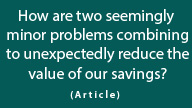Methodology Notes For Gold To Housing Ratio
By Daniel R. Amerman, CFA
Long-term averages have changed for both gold and housing relative to the 2011 analysis, because they include the interim years of data since that time.
Data for 1975 to 2016 is based on annual averages, where available as of August, 2016. Data for 2016 is based on the most recently available information at the time the research was being done, with a cut-off of August 19, 2016. Because housing statistics are lagged relative to gold prices (see below), this meant that June 2016 housing index numbers are being compared to August gold price numbers, for the most recent numbers only. While regrettable, this is the only way to incorporate the price of gold in more or less real time.
If comparing the 2011 and the 2016 analyses, please note that the 2011 analysis similarly also used the most recent data available as of November of 2011 for 2011, for the same reasons as above, while the 2016 analysis uses the annual averages for 2011 that later became available.
Obtaining timely and consistent national real estate statistics can be challenging relative to collecting information on securities such as stocks and bonds, for there is no daily closing price, and price change reporting may be delayed by months as the data is gathered. There are also the issues that where people live changes just a bit each year, as does the year of construction, size and amenities of an average home.
The "pairs-based" Case-Schiller index is the norm for media reporting of national housing price movements, but it treats most of the United States as an empty and meaningless void, prices are tracked only in 20 large metropolitan areas, and these can exhibit very different price behavior than the rest of the country.
The Freddie Mac House Price Index used herein includes all 50 states, as well as the other 300+ metro areas, making it a much better national measure, and it is also based on a pairs methodology which accounts for changes in average home size and amenities over the years. But the national average index slightly changes each year, in a way that is retroactive for all the previous years on the basis of "geographic weighting", which likely primarily reflects estimated population shifts, although Freddie won't release the methodology or the weights.
So the index and the ratio slowly drift just a bit with time, and what was a 99 Gold/Housing ratio for 1980 as calculated in 2011, retroactively become an 100 ratio for 1980 as calculated in 2016, due to changing "geographic weighting".
Because the Freddie measure is an index, a house value is needed to get dollar amounts, and the 2011 Q2 single family median home price from National Association of Realtors (NAR) was used in the initial 2011 analysis. Median versus mean can be another form of drift, and to prevent a double drifting, the 2011 measure was kept and multiplied by the 2016 index to get 2016 prices, rather than updating to a 2016 NAR median price that is somewhat higher than would be predicted by the pairs methodology used in the Freddie index.
As a side note, the drifting upwards in nationally average home prices captured in the geographic weights in the "pairs based" Freddie mean price index and the more rapidly increasing non-pairs based NAR median sale price would seem to indicate both a slow population shift towards more expensive areas, and the average single family home being just a little bigger or more upscale each year, as older housing stock in what are now less desired geographic areas is slowly replaced with more recently constructed housing stock in currently more desired areas, all of which is consistent with decades long trends.
It is also worth noting that caution needs to be used when comparing housing prices from decades past. As an example, the average price of home in 1982 is shown to be $41,084 in the "Accidental Prosperity" reading from the free course. Yet, the average price in the Gold/Housing Ratio analysis is shown to be $66,146.
Both are accurate.
The difference is that the average house in 2011 was larger and in a more urban (and expensive) market than it was in 1982. Using the pairs methodology used by both Case Schiller and Freddie Mac is necessary to keep the size and location "drift" from the numbers, but we aren't really looking at the average house in 1982, but rather what the average 2011 house would have sold for in 1982.
For 1975-2016 the annual average London price for gold as reported by Kitco is used (the base daily data is also available through the FRED2 database). The 2016 amount is based on the London pm price for August 18, 2016.
Inflation is based the Consumer Price Index for urban consumers, as reported by the US Bureau of Labor Statistics (BLS).
Gold To Housing Ratio or Housing/Gold Ratio?
The intent of this analysis is to describe a proportional relationship between two tangible assets in a manner that is intuitively understandable for the average person. The essential concept is how much gold (1) is required to purchase an average home (2) at different points in time. If you were to show up at the closing with a bag of gold instead of dollars, how much gold would you need to bring?
With a gold price of $1,350, the proportion is 180 to 1, and 180 ounces would be need to be brought to the closing. It is a ratio, there are no dollars, the ratio is that of (units of Gold) to (unit of Housing), there are 180 ounces of gold for a home, and it is easily understandable. If you have to bring more gold, you are paying more for the house, and if you have to bring less gold, then you are paying less for the house (in gold terms).
Mathematically, however, we start with a $243,301 home price, we then divide by a $1,350 per ounce price of gold, the dollars drop out, and that leads to the result that 1 average house is worth 180 ounces of gold. So the actual equation used throughout the analysis is Housing/Gold.
Most dictionary definitions of "ratio" contain two alternative meanings, each of which are common and acceptable usages. The first definition is mathematical, a quotient, the number of times the first contains the second. Because house price contains gold price 180 times, that means that "Housing/Gold ratio" is the correct term for the mathematical equation.
The second definition of "ratio" is a proportional relationship. As used in this article, the Gold To Housing ratio is the proportional relationship of how much gold it takes to buy a house. This is an entirely valid usage for "ratio" within the English language, however it is not intended to describe the underlying mathematical equation (house divided by gold) which was used to calculate the discussed proportional relationship (gold to buy a house).
While the sources of information and the calculations are believed to be accurate, this is not guaranteed to be true, this educational overview is not intended to be used for trading purposes, those making investment decisions should do their own research and come to their own independent conclusions, and any warranties or liability for the use of this information are expressly disclaimed.



















